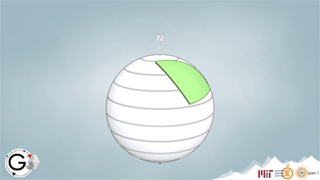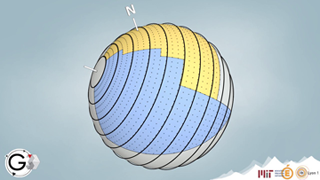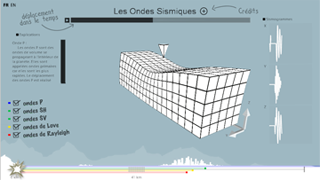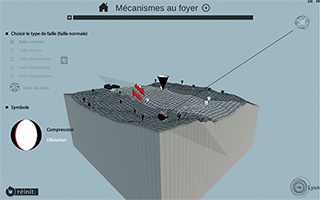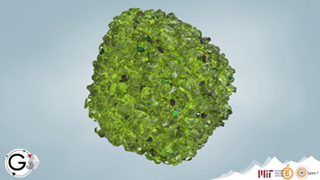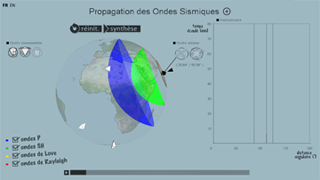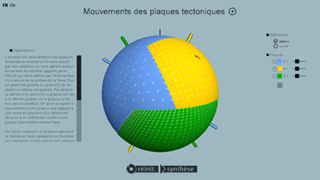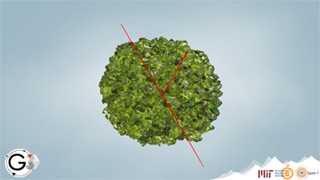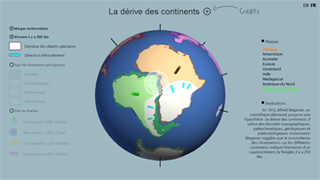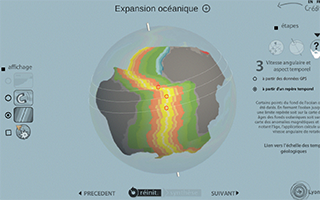Motion of a rigid plate accros the surface of the Earth
01/12/2012
This video illustrates the Euler's theorem, which is central to the theory of plate tectonics. Indeed, Euler's theorem is used to describe the velocity at any point of a rigid plate in motion at the surface of a sphere. Using 3D allows here to illustrate efficiently, unlike 2D projections, this theorem of spherical geometry, which has played a crucial role in the establishment of a fundamental theory in modern geosciences.
Scenario : Nicolas Coltice
Realisation : Frédéric Urien and Tom Rivière
Thanks : Denis Rebout
Plate tectonics
03/10/2016
This video displays the relative movement of 3 plates on the surface of a sphere. The use of 3D shows how the movement of a rigid plate corresponds to a block rotation. The location of ransform faults are direcly related to this rotation. On a sphere, the velocity varies within rigid plates, without internal deformation. Thus, this simple example shows the main features of the theory of plate tectonics.
Scenario : Nicolas Coltice
Realisation : Frédéric Urien and Tom Rivière
Thanks : Denis Rebout and Tristan Ferroir
Seismic Waves
12/11/2012
This 3D interavtice application allows you to visualize ground motion during the path of seismic P and S body waves and surface Rayleigh and Love waves.
Motion is simulated on a 3D block that can be positioned at a selected distance from an earthquake near the surface. The recording of the displacement by a virtual seismometer highlights the velocity differences between these seismic waves.
Motion is simulated on a 3D block that can be positioned at a selected distance from an earthquake near the surface. The recording of the displacement by a virtual seismometer highlights the velocity differences between these seismic waves.
Scenario : Nicolas Coltice
Realisation : Frédéric Urien and Tom Rivière
Focal mechanisms
12/11/2012
This application explains the link between the deformation in the source region where the seismic waves start due to a strike slip fault and the seismographic data.
You can place seismometers on the ground and then trigger the earthquake to see the first motion of P-waves. You can also change the fault direction (dextral or sinistral) or its orientation.
You can place seismometers on the ground and then trigger the earthquake to see the first motion of P-waves. You can also change the fault direction (dextral or sinistral) or its orientation.
Scenario : Nicolas Coltice
Realisation : Frédéric Urien and Tom Rivière
From atoms to rocks
11/01/2013
This video shows how rocks are composed, in this case a peridotite, which is typical of the upper mantle.
It shows the 3D structure of a rock at different scales: atomic, mineral and rock scales.
Use of the 3D here allows to clearly present the arrangement of atoms forming a crystal structure and important minerals of the mantle: olivine and pyroxene.
Use of the 3D here allows to clearly present the arrangement of atoms forming a crystal structure and important minerals of the mantle: olivine and pyroxene.
Scenario : Nicolas Coltice
Realisation : Frédéric Urien and Tom Rivière
Thanks : Anne-Line Auzende and Tristan Ferroir
Propagation of seismic waves
29/03/2013
When an earthquake occurs, the waves propagate in the interior and along the surface of the Earth. Seismometers record around the globe these complex signals.
This application allows you to visualize the differences of propagation and recording between body waves (P-waves and S-waves) and surface waves (Rayleigh waves and Love waves), in
a very simplified case: a homogeneous Earth, which would not have a nucleus. Only the direct waves are shown.
Place your earthquake and seismometers and follow the propagation and recording of the waves. Hodochrons will no longer be a secret.
Place your earthquake and seismometers and follow the propagation and recording of the waves. Hodochrons will no longer be a secret.
Scenario : Nicolas Coltice
Realisation : Frédéric Urien and Tom Rivière
Tectonic plates movements
30/03/2013
This 3D interactive application proposes to position simplified tectonic plates on the surface of a sphere, and choose the Euler pole and angular velocity describing their motion.
The surfaces velocities vary depending on the position of the pole and the intensity of the rotation. The produced surface kinematics generates virtual plate tectonics and can be projected onto a map.
Scenario : Nicolas Coltice
Realisation : Frédéric Urien and Tom Rivière
Brittle deformation of rocks
15/05/2013
This video shows the mechanism of brittle deformation. Deformation is observed at the atomic, the mineral and the rock scale.
The objective here is to show how brittle deformation, which generates faults and earthquakes, operates. Uniaxial stress case is presented for simplicity.
The objective here is to show how brittle deformation, which generates faults and earthquakes, operates. Uniaxial stress case is presented for simplicity.
Scenario : Nicolas Coltice
Realisation : Frédéric Urien and Tom Rivière
Ductile deformation of rocks
15/05/2013
This video presents a mechanism of ductile deformation by diffusion of vacancies within crystals.
There are other mechanisms of ductile deformation (dislocation creep for instance), but the principles are similar: ductile deformation produces shear zones with a continuous deformation, unlike faults. The mechanism is presented at the atomic scale, mineral scale and rock scale.
There are other mechanisms of ductile deformation (dislocation creep for instance), but the principles are similar: ductile deformation produces shear zones with a continuous deformation, unlike faults. The mechanism is presented at the atomic scale, mineral scale and rock scale.
Scenario : Nicolas Coltice
Realisation : Frédéric Urien and Tom Rivière
Continental drift
29/03/2015
This interactive 3D application allows to get into the skin of Alfred Wegener, who proposed continental drift in 1912.
The goal is to restore the position of the continents when they formed Pangea more than 200 My ago, using data from topography, paleoclimatology, geology and paleontology.
With real-time 3D, it becomes very easy to manipulate and position continents on the globe to form Pangea again.
Each step is guided by a link to educational activities proposed by the website of ENS Lyon ACCESS "Continental drift"
With real-time 3D, it becomes very easy to manipulate and position continents on the globe to form Pangea again.
Each step is guided by a link to educational activities proposed by the website of ENS Lyon ACCESS "Continental drift"
Scenario : Thierry Lhuillier, Agnès Rivière and Nicolas Coltice
Realisation : Frédéric Urien and Tom Rivière
From continental drift to plate tectonics
30/03/2015
This interactive 3D application shows how advances in various fields of science have helped to move from the theory of continental drift to the theory of plate tectonics.
First, you have to determine the pole of rotation of two plates ; then you can evaluate the angular velocity and then introduce the notion of time.
Each step is guided by a link to educational activities proposed by the website of ENS Lyon ACCESS."
First, you have to determine the pole of rotation of two plates ; then you can evaluate the angular velocity and then introduce the notion of time.
Each step is guided by a link to educational activities proposed by the website of ENS Lyon ACCESS."
Scenario : Thierry Lhuillier, Agnès Rivière and Nicolas Coltice
Realisation : Frédéric Urien and Tom Rivière

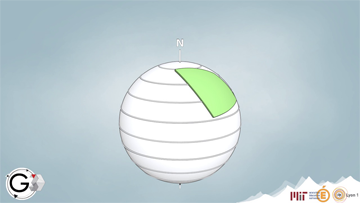
Motion of a rigid plate accros the surface of the Earth

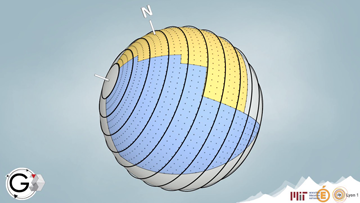
Plate tectonics

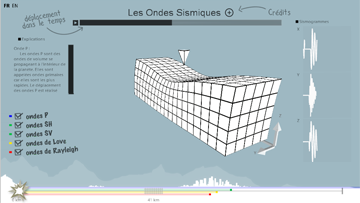
Seismic Waves


Focal mechanisms

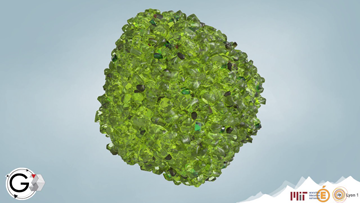
From atoms to rocks


Propagation of seismic waves

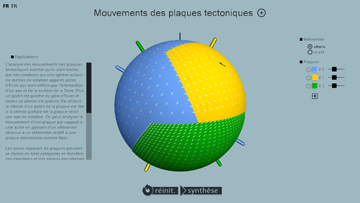
Tectonic plates movements

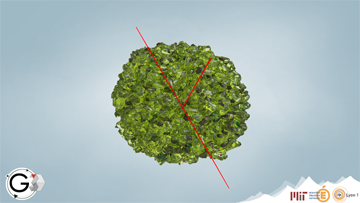
Brittle deformation of rocks

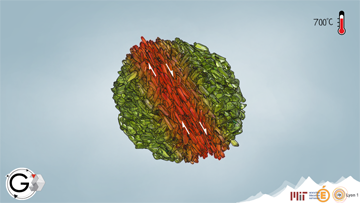
Ductile deformation of rocks

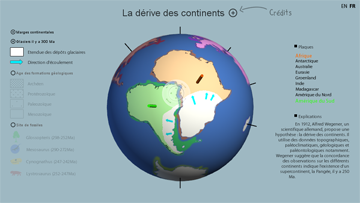
Continental drift

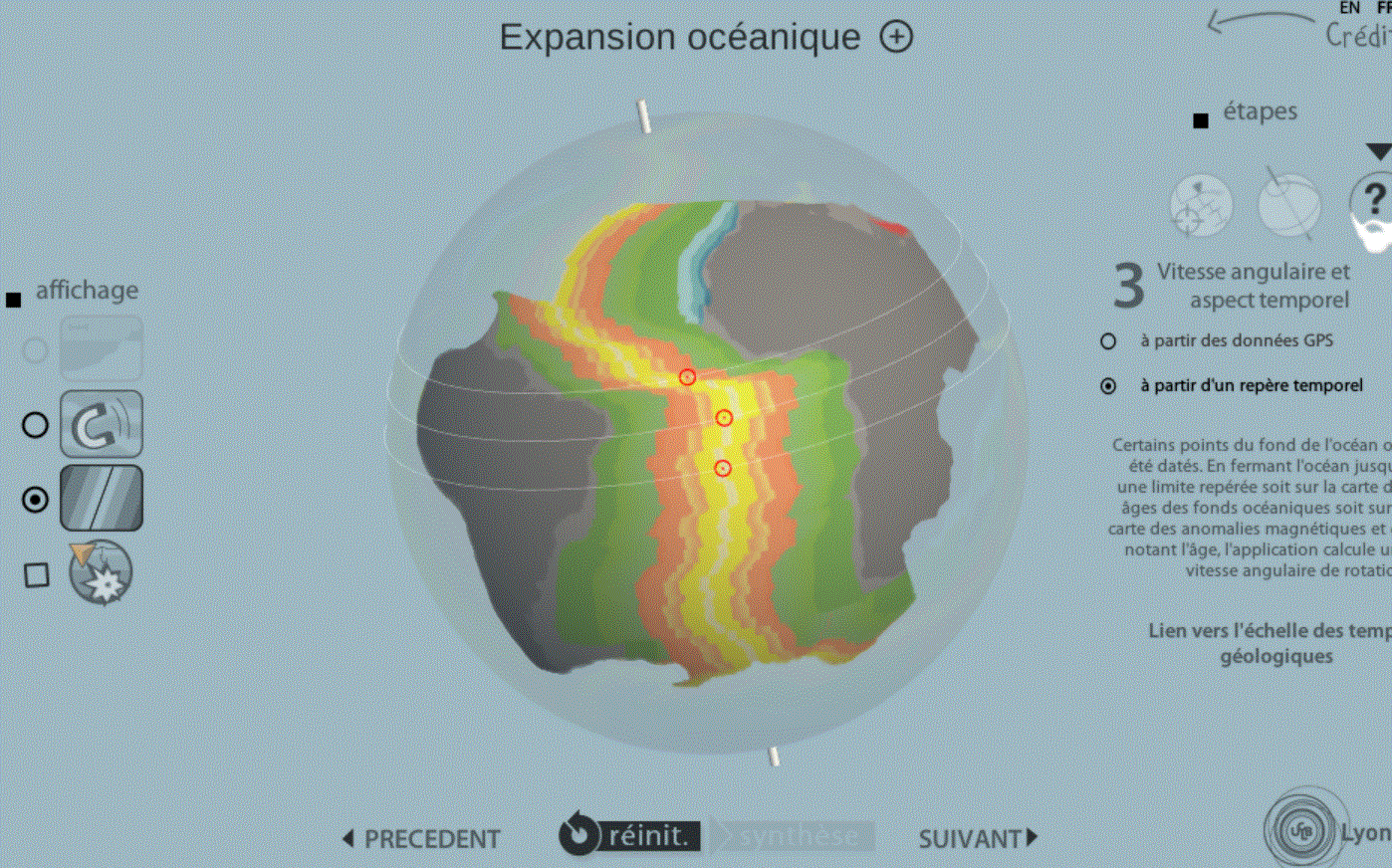
From continental drift to plate tectonics

Motion of a rigid plate accros the surface of the Earth

Plate tectonics

Seismic Waves

Focal mechanisms

From atoms to rocks

Propagation of seismic waves

Tectonic plates movements

Brittle deformation of rocks

Ductile deformation of rocks

Continental drift

From continental drift to plate tectonics
